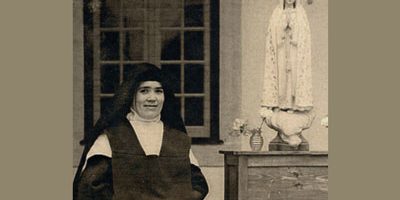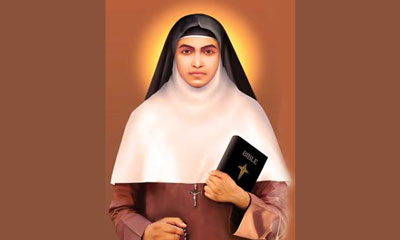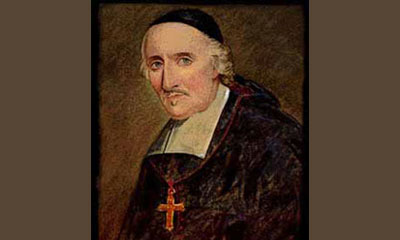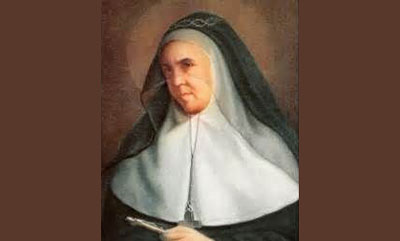January 17, 2018
Sister Lucia
Dear Friends,
“At Fatima,” Pope Francis said this past May 14th, “the Virgin chose the innocent heart and simplicity of little Francisco, Jacinta and Lucia, as custodians of her message. … With the canonization of Francisco and Jacinta, I wanted to propose to the entire Church their example of bonding with Christ and their evangelic witness, and I also wanted to urge the entire Church to take care of children. Their holiness is not the consequence of the apparitions, but of their faithfulness and the ardor with which they responded to the privilege of being able to see the Virgin Mary. After the encounter with the ‘Beautiful Lady’—as they called her—they frequently recited the Rosary, they did penance and offered sacrifices to bring about the end of the War, and for the souls most in need of divine mercy.” Lucia remained on earth longer than her two cousins, just as the Virgin had told her.
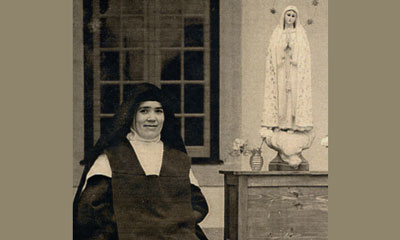 For on June 13, 1917, during the second apparition of Our Lady of Fatima, Lucia, the oldest of the three young shepherds, asked the heavenly visitor to take them to Heaven. “Yes,” replied the Virgin, “I will take Jacinta and Francisco soon. But you are to stay here some time longer. Jesus wishes to make use of you to make me known and loved. He wants to establish in the world devotion to My Immaculate Heart. To whoever embraces this devotion, I promise salvation; these souls shall be dear to God, as flowers placed by me to adorn His throne.” Some time longer? For Lucia, this would be nearly ninety years…
For on June 13, 1917, during the second apparition of Our Lady of Fatima, Lucia, the oldest of the three young shepherds, asked the heavenly visitor to take them to Heaven. “Yes,” replied the Virgin, “I will take Jacinta and Francisco soon. But you are to stay here some time longer. Jesus wishes to make use of you to make me known and loved. He wants to establish in the world devotion to My Immaculate Heart. To whoever embraces this devotion, I promise salvation; these souls shall be dear to God, as flowers placed by me to adorn His throne.” Some time longer? For Lucia, this would be nearly ninety years…
“We want it!”
The seventh child of Antonio and Maria Rosa dos Santos, Lucia was born on Holy Thursday, March 28, 1907, in the hamlet of Aljustrel, near Fatima, in central Portugal. She was baptized on Holy Saturday. Maria Rosa, a woman whose heart was full of tenderness, raised her children firmly, and because she loved them very much, did not tolerate any misbehavior. In spring 1913, Lucia made her First Communion. She felt herself overcome by a profound peace: “Lord, make me a saint,” she said from the bottom of her heart, “keep my heart always pure for You alone!” She was given the task of leading the family’s sheep to pasture. In 1916, her cousins Francisco and Jacinta joined her. Three times that year, an angel appeared to them and exhorted them to pray much and make sacrifices in reparation for the sins that offended God. On May 13, 1917, the Most Blessed Virgin appeared to them at the Cova da Iria, a plot of land that belonged to Lucia’s family. “Do you want to offer yourselves to God to endure all the sufferings that He wishes to send you, in reparation for the sins by which He is offended, and in supplication for the conversion of sinners?” “Yes, we do.” “You will suffer greatly, but God’s grace will be your comfort. Say the Rosary every day to obtain world peace and the end of the war.”
From then on, Lucia began to suffer trials. In spite of her promise to keep the secret of the apparition, Jacinta could not keep herself from recounting what she had seen. When Lucia’s family learned of it, they refused to believe the apparitions were real. Maria Rosa thought her daughter was lying and could not accept it. After June 13, inquisitive people started coming and questioning Lucia; their impudence bothered Maria Rosa. What is more, the crops in Cova da Iria were trampled by the pilgrims, for which Lucia was blamed. The parish priest declared that her visions could well be a deception by the devil, throwing Lucia into great distress.
Discouraged by this opposition, Lucia was on the point of abandoning everything and saying that it had been just a lie. She told her cousins that she would no longer go to the rendezvous set by the celestial apparition for the 13th of each month, because she was afraid that it was the devil. However, on July 13th, moved by a mysterious force, Lucia came and took her cousins to the Cova da Iria. The beautiful Lady was there as promised. For the third time, she asked for daily recitation of the Rosary, and whenever possible, said as a family. She confirmed the necessity of offering sacrifices for the conversion of sinners, and in reparation for offenses against the Heart of Jesus and Her Immaculate Heart. Then she shared with them a secret in three parts. She showed them, in a vision of hell, the terrible fate reserved for unrepentant sinners. Then she gave mankind a means of avoiding this eternal suffering: devotion to Her Immaculate Heart. This devotion could also obtain peace between nations. Our Lady described the dire consequences for the world if Her requests were not followed—a new war would break out, and persecutions would come from Russia, which would spread its errors throughout the world. On the other hand, “if my requests are heard,” the Virgin Mary declared, “Russia will be converted and there will be peace.”
Boiling in oil
On August 13, the three shepherds were not at the set rendezvous. The spreading fame of the events in Fatima was making the anticlerical government uneasy. The children were taken against their will to Vila Nova de Ourèm, where the district administrator tried to get them to reveal the secret given by the Lady. He went so far as to threaten to throw them in a cauldron of boiling oil if they did not comply. Terrified by this threat, they nevertheless did not speak. Defeated by their courage, the administrator returned them home on August 15. On the 19th, Our Lady appeared to them and told them she would perform a miracle in October. “Pray, pray a great deal,” She told them, “and make many sacrifices for sinners. For many souls go to hell because they have no one to make sacrifices and to pray for them.” Many years later, in 1946, someone asked Sister Lucia: “What is Our Lady’s primary request?” “Sacrifice.” “What do you mean by sacrifice?” “By sacrifice, Our Lady has said she means the faithful performance of the duties of one’s state.” “But isn’t the Rosary important?” “Yes, because we must pray to gain the strength to be capable of carrying out our daily duties.” In her book Calls from the Message of Fatima, she would clarify: “Many give to the word ‘penance’ the sense of great austerities, and as they feel neither the strength nor the generosity for that, they become discouraged and give into a life of lukewarmness and sin.”
On October 13, the heavenly apparition revealed her name: Our Lady of the Rosary. She asked that a chapel be built in her honor, and again emphasized the recitation of the Rosary. Lastly, with great sadness, she added: “May no one further offend God Our Lord, Who is already greatly offended!” As the apparition rose into the sky, Lucia exclaimed, “Look at the sun!” The miraculous sign was taking place that had been promised to confirm the truth of the apparitions. The heavy rain stopped, the clouds dissipated, and the sun appeared. Everyone could look at it without being blinded. Three times the sun started spinning around, throwing beams of light that illumined the people and the countryside in different colors. Suddenly the entire multitude, seized with fear, began to scream—it seemed that the sun had become detached from the sky and was plunging to the earth! Many loudly confessed their sins, and made acts of faith and contrition. This dance of the sun was observed by 70,000 witnesses, in a radius of 40 kilometers around Fatima, so it could not be a collective illusion. At the end of the miracle, people noted that their clothes, which had previously been drenched, were completely dry.
“Our Lady foretold, and warned us about, a way of life that is godless and indeed profanes God in His creatures. Such a life—frequently proposed and imposed—risks leading to hell. Mary came to remind us that God’s light dwells within us and protects us,” said Pope Francis (Homily for the Canonization of Blesseds Francisco Marto and Jacinta Marto, May 13, 2017). Indeed, the Fatima message is the message of a mother who is concerned about the welfare of each of her children, whom she reminds that mankind’s greatest evil is sin, which leads to hell and causes wars. “To the eyes of faith,” teaches the Catechism of the Catholic Church, “no evil is graver than sin and nothing has worse consequences for sinners themselves, for the Church, and for the whole world” (CCC, no. 1488). Mary invites us all to place ourselves under the protection of Her Immaculate Heart, to live in the light of God and obtain peace for the world.
Remaining alone
On April 4, 1919, Francisco, stricken with the Spanish flu, left this world. Jacinta died from the same disease on February 20, 1920. Lucia found herself alone to carry out the mission that Heaven had entrusted to her. In June 1921, she met Bishop da Silva, the bishop of Leiria, who became a second father to her. To protect her from the curious, the prelate deemed it necessary to send her away to pursue her studies at the school run by the Dorothea sisters in Vilar, a suburb of Porto. On June 15, Lucia, fourteen years old, left Fatima for good. Kneeling one last time at the Cova da Iria, she cried and begged forgiveness from Our Lady, for she did not feel able to offer her the sacrifice of going away. The Blessed Virgin then appeared to her and encouraged her, in keeping with her promise: “I will never abandon you,” that she had given her on June 13, 1917. “My Heart will be your refuge and the path which will lead you to God.” At Porto, Lucia received a new name: Maria das Dores (of the Sorrows). “Dores,” as she was called, was not allowed to speak about the apparitions, or about her village or her family, causing her many humiliations at the hands of her classmates, who did not understand. However, she endured everything in silence, and offered with love the thorns she encountered, repeating the prayer she had learned from Our Lady: “O Jesus, it is out of love for you, for the conversion of sinners and in reparation for the sins committed against the Immaculate Heart of Mary.” There she was no longer the famous seer of Fatima, but an ordinary student. Nevertheless, she had a certain indescribable something that gave her an influence over her companions, and made her respected and loved, including by the teachers. A talented student, Dores wanted to go on to high school, but she could not do so without revealing her identity. A storm then arose in her soul: she wished to study so that she might better spread the message entrusted by Heaven, and wished to take charge of her own life again. She poured out her sorrow before the tabernacle: “Do not be sad,” Jesus told her, “you will not study, but I will give you My Wisdom. The message is entrusted to the care of My Hierarchy.”
“Try to console me!”
On August 26, 1923, Dores was admitted to the Children of Mary, and she dedicated herself entirely to God through a private vow of perpetual chastity. Summers, she spent her vacation in the country, in a group around the Bishop da Silva, to whom she opened her heart. For the summer of 1925, Maria Rosa joined her daughter; it was at this time that Lucia obtained her consent to become a nun. Since the apparitions, she had felt attracted to Carmel, but she had been told that her health was too poor for that order, and that it would be better for her to join the Dorothean Sisters, who devoted themselves to education. Lucia left Porto on October 25 to become a postulant among these religious in Pontevedra, in Spanish Galicia. Six weeks after her arrival, on December 10, 1925, the Blessed Virgin and the Child Jesus appeared to her: “Have compassion on the Heart of your Most Holy Mother,” said the Child Jesus. Our Lady added, “Look my daughter, at my heart, surrounded with thorns with which ungrateful men pierce me at every moment by their blasphemies and ingratitude. You at least try to console me and announce in my name that I promise to assist at the moment of death, with all the graces necessary for salvation, all those who, on the first Saturday of five consecutive months shall confess, receive Holy Communion, recite five decades of the Rosary, and keep me company for fifteen minutes while meditating on the fifteen mysteries of the Rosary, with the intention of making reparation to me.”
In July 1926, Lucia joined the novitiate in Tuy (Spain), and received the habit there on October 2, under the name of Sister Maria das Dores. At her confessor’s request, she put into writing her testimony on the practice of the first five Saturdays of the month. This text reveals once more God’s will to establish in the world devotion to the Immaculate Heart of Mary. On October 3, 1928, in spite of her persistent attraction to cloistered life, Sister Dores made her first vows with the Dorothean Sisters. One of her main duties was in the laundry, where she excelled. Indeed, she could sew very well, and did everything with great precision.
Sister Dores had received permission to remain alone in the chapel every Thursday night, from 11 o’clock until midnight. During the night of June 29, 1929, the chapel lit up—on the altar appeared a Cross of light that rose up to the ceiling. Under the right arm of the Cross was Our Lady holding Her Immaculate Heart in her right hand: “The moment has come,” she said, “in which God asks the Holy Father to make, in union with all the bishops of the world, the consecration of Russia to my Immaculate Heart. He promises to save it by these means.” On May 29, 1930, Our Lord indicated to her that it was necessary to ask the Holy Father for approval of the devotion of the first Saturdays of the month and for the consecration of Russia, which had not been made yet. That same year, on October 13, Bishop da Silva solemnly proclaimed, before more than 100,000 faithful gathered at the Cova da Iria, the divine origin of the apparitions.
Another martyrdom
Sister Dores made her perpetual profession on October 3, 1934. Sent shortly thereafter to Pontevedra, she lived there during the first months of the Spanish Communist revolution, before returning to Tuy. She was prepared to accept martyrdom if God wished to give her this grace. “He had reserved for me,” she would later say, “another martyrdom, which perhaps was not easier, the slow hammering of renunciation that crucifies and immolates.” During the years of the Second World War, food became scarce, and the sisters suffered from hunger. However, Portugal continued to be spared from the scourge of war, as Lucia had written to the Holy Father on December 2, 1940: “Our Lord promises, in taking into consideration the consecration that the Portuguese bishops made of the nation to the Immaculate Heart of Mary, a special protection of our country during this war, and that this protection will be the proof of the graces He would grant to other nations if they were similarly consecrated.” On October 31, 1942, Pope Pius XII consecrated the Church and the world to the Immaculate Heart of Mary, mentioning Russia indirectly. On May 4, 1943, Sister Dores wrote, Our Lord “promises the end of the war is coming, considering the act that His Holiness has deigned to make. But since it was incomplete, the conversion of Russia will be later.” On March 25, 1984, John Paul II, in union with all the bishops of the world, would renew this consecration. Sister Lucia wrote then that this act had been made in the manner in which Our Lady had wanted.
At the request of Bishop da Silva, Sister Lucia wrote four memoirs between 1935 and 1941. Everything about Fatima was revealed in these memoirs, with the exception of the third part of the secret. In 1943, the prelate wished that she put this third part into writing. Very much at a loss, the sister appealed to Mary who, on January 2, 1944, gave her permission to write it, but specified that this text could not be divulged before 1960. After this date, many people would ask for the third secret to be revealed, but Sister Lucia would say: “If only people lived what is most important, which has already been said! They are only concerned with what remains to be said, instead of doing what has been asked for: prayer and penance!”
In May 1946, Sister Dores returned to Porto. On the 21st, she had the joy of making a pilgrimage to Fatima. Shortly thereafter, she wrote: “The crowds ran after me, searching for the supernatural that they did not find in this world. I therefore want my steps to leave a trail of light to show them by faith the path to Heaven.” Her desire to enter Carmel became ever more intense: “It is not that I think I will find in Carmel a life full of roses. No, I think that even if I pick one, it will perhaps have sharper thorns… What I want to find in Carmel are the walls of a cloister that will shelter me from the immeasurable flood of curious and indiscreet eyes, so that I might have a life of recollection and more intense intimacy with the Lord.” In 1947, she disclosed this desire to Pius XII in secret. The Pope discerned in it God’s will, and gave her permission to carry it out. As a result, she entered the Carmel in Coimbra on Holy Thursday, March 25, 1948, taking the Carmelite habit on May 13. On May 31, 1949, the feast of Mary Mediatrix of all graces, she made her solemn profession and received the name Sister Maria Lucia of Jesus and of the Immaculate Heart. Her eyes ever fixed on Mary, she let herself be led to the Trinitarian God of Love, in a life of faith that experienced moments of intense darkness.
The sisters’ joy
In community, Sister Maria Lucia lived simply, and did not draw attention to herself. With her joyful appearance, her big smile and her ready sense of humor, she delighted the sisters during recreation. Not wanting to take a step that was not marked with God’s seal, she obeyed her superiors with great delicacy of conscience. Always compliant, she accepted or left any duty in accordance with what was asked of her. However, in Carmel, she did not manage to completely escape visits. These weighed on her—they were, she affirmed, “a piece of my cross, but they are also part of the mission that God has entrusted to me. Not even in Heaven will they leave me in peace, but there I’ll receive them with more generosity, because there will no longer be any danger of disrupting the union of my soul with God…” Later, people who wished to meet Sister Lucia would have to have authorization from the Holy See. However, she remained very busy with her voluminous correspondence—from all over the world, people begged for her prayers for relief from physical and moral sufferings.
Sister Lucia would return to Fatima when Pope Paul VI, and later Pope John Paul II, went there on pilgrimage. In the year 2000, when the beatification of her cousins Francisco and Jacinta was announced, her heart pounded with new fervor, so much had she desired this event, which her testimonies had paved the way for. But her health began to decline. She reached the point that she was no longer able to walk and was able to move around only in a wheelchair. Her serenity and good humor were not shaken, although she admitted: “No one wants to die young, but it’s tough to be old!” From November 2004 on, she no longer left her cell. On February 10, 2005, in intense suffering, she said her last words: “I offer for the Holy Father,” then entered into a profound silence for her final days. On the morning of the 13th, she received the blessing of Pope John Paul II, sent by a fax that she was able to read herself: “Reverend Sister Lucia of Jesus and of the Immaculate Heart, I come to reaffirm my affectionate union, with particular mention of your person before the God of all consolation, so that you might, serenely and resignedly, overcome in a meritorious manner these moments of trial, united with Christ the Redeemer and allowing yourself to be enlightened by His Passover…” In the evening, in the presence of the bishop of Coimbra and the entire community, Sister Lucia died peacefully, her eyes fixed on the crucifix that her Mother Prioress held. The government of Portugal declared a national day of mourning on the day of her funeral, which was celebrated at the cathedral in Coimbra on February 15. The edifice proved to be too small to contain the crowd. Sister Lucia’s body was buried in the Carmel’s cloister before it was transferred to Fatima the following year, on February 19, 2006. The diocesan inquiry for her beatification was formally completed on February 13, 2017.
Following Sister Lucia’s example, let us consecrate ourselves to the Immaculate Heart of Mary, so as to live under the gaze of Our Lady of the Heavens as long as the Lord leaves us here below.


